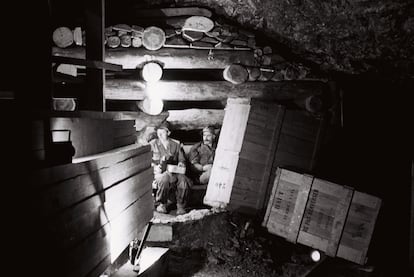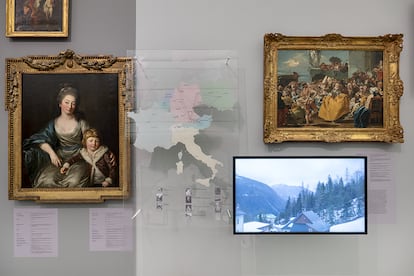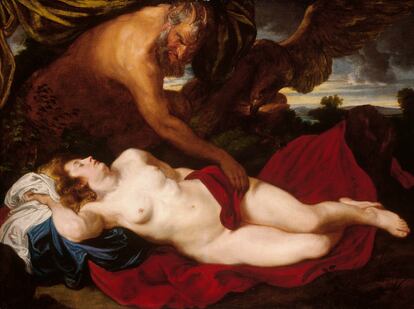Adolf Hitler’s immeasurable legacy as a looter of works of art
Pieces stolen by the Nazi regime in occupied Europe star in three ambitious simultaneous exhibitions in Austria

Everything is breathtaking in Salzkammergut. In this alpine region where picturesque villages such as Hallstatt, primary forests, lakes, and the Dachstein glacier flourish, the Nazis hid a treasure trove of almost 10,000 works of art underground. A total of 1,428 pieces came from Austria’s most important national museums, such as the Belvedere, the Albertina, and the Museum of Art History in Vienna, but most of them were works looted in Europe under the occupation of the Third Reich, which Hitler planned to use as the basis of the megalomaniacal Führer Museum in Linz.
The story was the fruit of necessity. The art had to be saved from Allied bombings and the last bastion of the Nazi resistance in the Alps was chosen. Artillery trucks were loaded with works by artists such as Vermeer, Rembrandt, Tintoretto, and Pieter Brueghel the Elder; there were also sculptures such as The Madonna of Bruges, created in marble by Michelangelo, which left Belgium wrapped in mattresses, and The Adoration of the Mystic Lamb, a medieval polyptych by Jan van Eyck looted from Ghent Cathedral and transported during the snows of the winter of 1943 to the catacombs of the Altaussee salt mine. The following year the masterpieces from the Viennese museums were moved to the Lauffen salt mine. Hitler’s strategy had worked and the head of Heritage in Vienna copied the idea. Now the Lentos art museum in Linz has managed to collect more than 80 of these works, including pieces by Goya, Titian and Liebermann and degenerate artists such as Munch and Corinth, for display in the exhibition The Journey of the Paintings.
The exact place where they were hidden in the Altaussee mine, 140 kilometers (87 miles) from Linz, can still be visited. The setting has not changed at all. George Clooney approached the story in Monuments Men, a film that appropriates the real events to make the story work like an episode of the A-Team. The movie’s promotional poster paradoxically hangs on a wall of the Lentos. The real denouement is perhaps too twisted to be believable on film: the Nazi leader of the region, SS gauleiter obergruppenführer August Eigruber, ordered eight sealed wooden boxes inscribed with “Caution / Marble” to be installed next to the artworks. Inside they held half a ton of explosives each. They were well camouflaged. Along with the 6,500 paintings, 130 sculptures, 120 tapestries and 480 drawings, there were another 1,700 wooden boxes containing antiquarian books. The Nazis’ intention was to blow up the mine and its contents if things got ugly, which they did.

The miners were alarmed. Altaussee is not just any deposit: it was the Habsburgs’ main source of wealth and today remains active as Austria’s most important salt mine, with 50 tons of salt extracted from its bowels every hour. After Germany annexed Austria, the monopoly over this production was controlled from Berlin. The workers sensed that, along with the works of art, the region’s great economic vein was in danger and, in desperation, they grasped at a Nazi straw: Ernst Kaltenbrunner, the head of the Gestapo, who was hiding with his mistress in a nearby villa. Kaltenbrunner intervened to their favor and on the night of May 4, 1945, the miners removed the bombs and hid them in the forest until the arrival of the U.S. army on May 8. Eigruber was hanged for his responsibility for the crimes committed at Mauthausen and its satellite camps. Kaltenbrunner, too.
The exhibition at the Lentos is part of an ambitious trilogy linked to Bad Ischl’s status as one of the European Capitals of Culture in 2024. The second exhibition, in Bad Aussee, is dedicated to the art dealer Wolfgang Gurlitt (1888-1965), an unscrupulous speculator during the Nazi era. He traded, trafficked, and did business with the Nazis while using his partner and Jewish concubine Lilly Agoston as a front. The daring method he found to spare Agoston from the gas chamber was a marriage of convenience with a young man from Denmark, which allowed them both to hold Danish passports to trade in degenerate art in exchange for fresh foreign currency for the Reich. Always beset by creditors and a hedonistic lifestyle, his house was paid for by his wife and ex-wife with his own money (he lived with all three women, much to the bewilderment of visiting socialites). His daughters were never allowed to work because, he said, “a Gurlitt does not work.” He was the representative of painters including Picasso, Liebermann, Schiele, Klimt, and Kokoschka. He had a close friendship with the latter, an artist persecuted by the Nazis who narrowly escaped the extermination camps. Gurlitt was the first to exhibit his work again in Austria in 1949, with pieces by Klimt, Schiele and Kubin.

By this time Gurlitt was the owner of an infamous number of works that had belonged to Jewish collectors and had come indecipherably into his hands during World War II. When his Berlin residence and art gallery were destroyed in an Allied bombing raid in November 1943, one of the reasons he moved from greater Berlin to provincial Bad Aussee, where today he stars in this exhibition at the Kammerhofmuseum, was to cash in on the Aryanization of Jewish mansions. His collection is the origin of the Lentos, which changed its name in 2003 from the New Gallery of the City of Linz-Wolfgang Gurlitt Museum. Today, 12 paintings from the Gurlitt collection that were acquired by the City of Linz have been returned to their rightful heirs. Among them is Klimt’s valuable portrait of Ria Munk, which until 2009 was on display in the museum.
“A dandy who worked to fill the Führer Museum with works of art,” says Michael John, an expert on art plundered during the Third Reich who was consulted in the Munk family’s proceedings. John is leading the reopening of the Museum of Bad Ischl, announced for July, one of the city’s flagship actions as European Capital of Culture. The museum will have a name and a Biedermeier facade reminiscent of the sets of filmmaker Wes Anderson: Hotel Austria.

Lauffen, on the outskirts of Bad Ischl, was chosen to host the latest exhibition because this is where the second salt mine used as an art bunker was located. “But in addition to Hitler’s art theft, another important aspect is the looting of works of art that is in full swing even today. This is a task that Europe must urgently tackle,” says Elisabeth Schweeger, artistic director of the European Capital of Culture Bad Ischl. It is with this approach that The Life of Things, Looted — Displaced — Salvaged opens, addressing the theft of state-planned art and expropriations (or “Aryanizations”) carried out under the German Reich and examining — guided by the work of 14 contemporary artists — the colonial exploitation in the Democratic Republic of Congo, the plundering in Iraq, or the cultural destruction in Lebanon.
The three exhibitions dedicated to Nazi plundered art and the Hotel Austria can be visited throughout the summer. They will coincide in the Salzkammergut agenda with traditional events such as the Bad Goisern chamois beard olympiad.
Sign up for our weekly newsletter to get more English-language news coverage from EL PAÍS USA Edition
Tu suscripción se está usando en otro dispositivo
¿Quieres añadir otro usuario a tu suscripción?
Si continúas leyendo en este dispositivo, no se podrá leer en el otro.
FlechaTu suscripción se está usando en otro dispositivo y solo puedes acceder a EL PAÍS desde un dispositivo a la vez.
Si quieres compartir tu cuenta, cambia tu suscripción a la modalidad Premium, así podrás añadir otro usuario. Cada uno accederá con su propia cuenta de email, lo que os permitirá personalizar vuestra experiencia en EL PAÍS.
¿Tienes una suscripción de empresa? Accede aquí para contratar más cuentas.
En el caso de no saber quién está usando tu cuenta, te recomendamos cambiar tu contraseña aquí.
Si decides continuar compartiendo tu cuenta, este mensaje se mostrará en tu dispositivo y en el de la otra persona que está usando tu cuenta de forma indefinida, afectando a tu experiencia de lectura. Puedes consultar aquí los términos y condiciones de la suscripción digital.
More information
Archived In
Últimas noticias
Welcome to the post-religion era: The idea of Christianity as the absolute truth has become obsolete
‘I thought you would like it’: The risky sexual practice popularized by TV shows and TikTok
The digitalization of tourism: ‘They promise experiences and gave us the worst possible one’
Mexican peso defies uncertainty with forecasts of a new period of stability in 2026
Most viewed
- Sinaloa Cartel war is taking its toll on Los Chapitos
- Oona Chaplin: ‘I told James Cameron that I was living in a treehouse and starting a permaculture project with a friend’
- Reinhard Genzel, Nobel laureate in physics: ‘One-minute videos will never give you the truth’
- Why the price of coffee has skyrocketed: from Brazilian plantations to specialty coffee houses
- Silver prices are going crazy: This is what’s fueling the rally











































